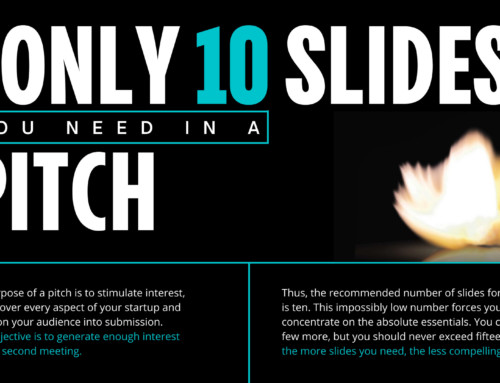Have you heard of the concept called “disrupt-then-reframe”? The theory is that you introduce a non-sequitur or unexpected element into your pitch and then immediately inject a call-to-action. The disruption theoretically neutralizes critical thinking and makes a person more susceptible to agree.
This concept is the result of a study by Barbara Davis and Prof. Eric Knowles in which they sold note cards door-to-door for a charity. When they told people that the cards were eight for $3.00, they had a 40% success rate. When they told people that the price was eight for three-hundred pennies and then said, “which is a bargain,” 80% of the people bought cards.
Give it a shot and let me know if the concept works for you. I suspect that venture capitalists will be very susceptible because they have attention deficits anyway. Here’s how it would work. Suppose that you’re negotiating an investment; just say: “Our pre-money valuation is 500,000,000 pennies which is a bargain for a Web 2.0 company.”
PS, did I tell you that you can read the Truemors web site for zero pennies which is a bargain? Just click here. :-)




I don’t know Guy, going to a meeting and saying “this project only costs you 100 000 000 pennies” would probably make the decision maker look at you kinda weird. Small things, this can work but big ticket items I think not so much.
Jon
Guy,
The typical presenter in front of a VC or Angel is usually thinking about what is on the next slide and or how to defend thier business model….but the pros who present to a lot of VC’s might want to give this a try.
Hopefully those that try this (the penny routine…or they could even change up and say for 5000 british pounds:) will give you feedback on how it works and you can update us all later in another post.
“PS, did I tell you that you can read the Truemors web site for zero pennies which is a bargain? Just click here. :-)”
Good example of Disrupt-Then-Reframe Selling, I clicked on the link!
Gotta agree with Jon. Speaking in pennies would seem to be a good way to make oneself appear awkward.
I highly doubt that VCs fall into the 80% of population who would fall for it. After all, 80% of the population are living normal life and do not have to deal with numbers and issues the same way VCs do! The entrepreneur would look naive at best should s/he do this!
Introducing an ‘unexpected element’? Yes, if relevant.
Introducing a ‘non-sequitur’? Really, Guy?
In your example of note cards, the ‘bargain’ tack was unexpected but not a non-sequitur. However they introduced TWO changes in their pitch – the monetary unit and the bargain pitch. It is unclear from that link how they figured to which change they should attribute the higher sales rate.
The concept is great. Disrupt-then-restate in different terms. The examples – including yours – are lousy.. Sorry.
How about using some of the units that Wired highlighted the other day? Wired: Units of Measure
“That’s only 4000 score dollars!”
or “We can store over a million nibbles!”
Yes I agree, the disrupt-then-reframe technique is working very well.
I think this technique is very good to break the natural disagreement to new ideas and proposals.
Yours Sincerely.
I know of a cents to dollars story that killed a sale: The prospective client, asked what the ad investment would be, answered “120 mio d’anciens francs “. Being the NF (nuoveau franc, two zeros off) two years old, my account executive asked: “Ca veut dire 12 miliards d’ancien centimes ?” The client was not amused.
“Disrupted Development” Theory…
Today’s Notable Quote: I’ve figured out how to make money while I’m working! – GOB (George Oscar Bluth II) Bluth (played by actor Will Arnett) from Arrested Development. Guy Kawasaki’s blogpost today reminds me of one of the magic acts
I used to visit the website everyday. But the content has become derivative and often drivelous. It is coming out of my Bookmarks today.
Maybe the examples are concocted, but I think the true strength of this method isn’t in the obvious scams like talking about cost in pennies, but instead the recognition that creating cognitive dissonance and then resolving it makes people more receptive.
People want to understand, and so they jump at the chance, even if that means accepting what you are saying.
Consider presenting results of an analysis by starting with a confusing result and then suddenly paring it down to one major point, for example. There are a million applications of this sort of strategy.
This sounds like a version of “If you can’t impress them with your intelligence, baffle them with bu**sh**.”
I think that disrupt-then-reframe technique is so new yet so familiar.
I think this works not because of the complicated psychological explanation but simply because the sales talk stands out.
You´re already a nice guy because you´re not insulting peoples intelligence with the standard talk. :)
If a salesperson tried this reframe trick on me I’d go – ah, the reframe trick – and their *credibility* would tumble significantly. Do salespeople really think we don’t see this sort of thing coming? Do they assume we are stupid enough to be hood-winked by a dumb trick? Not a great sales idea IMHO.
YOUR what a bargin about $3.00and 300pennies give me a lecture again in my life. i would share this story with my friends at millionairematch.com and let them know more too.